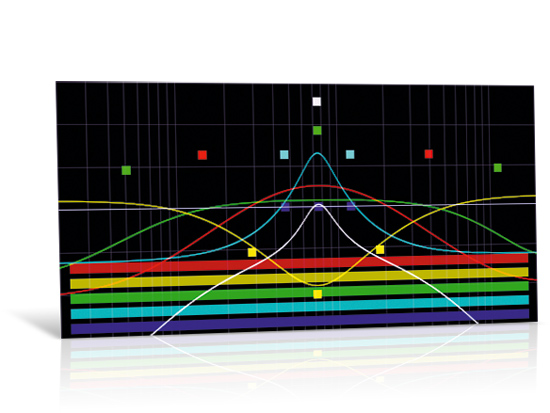19 essential EQ tips
Your fast-track guide to better equalisation

EQ is a vital tool in any producer´s arsenal, but knowing when and how to use it isn´t always easy. Allow us to give you some guidance…
1. Try and avoid massive cuts and boosts unless they´re absolutely necessary. Generally, an adjustment of just a few dB will be enough.
2. FX channels, particularly reverb, can often harbour untreated low rumble, even if you´ve cut most of the unwanted low-end from the tracks feeding to them. A mix can really benefit from applying high-pass filtering to its reverb channels.
3. Remember that while soloing a track can be helpful at times, it won´t necessarily help you sit the instrument in a full mix.
4. If you add 10dB at 150Hz, 10dB at 1kHz and 10dB at3kHz, all you´re really doing is boosting the volume of the track by 10dB. Just because the volume is louder, you might mistakenly perceive the track as ‘better´ - don´t be seduced.
5. When it comes to the bottom end of a track, you´re looking for clarity rather than just lots of ‘woofing´. Be sure to apply a high-pass filter to instruments that have no real low-end content. Below 50Hz, guitars will just add cabinet rumble to the mix. Below 80Hz, rumble from the mic stand (or a tapping foot) is all you´re likely to get from a vocal.
6. You may find yourself automatically adjusting EQ just because you feel you should - don´t make changes unless your ears tell you they´re needed. Many parts won´t need any EQ at all.
Want all the hottest music and gear news, reviews, deals, features and more, direct to your inbox? Sign up here.
7. While modern EQ plug-ins can work wonders, nothing beats having a high-quality original recording. Don´t rush the process of getting a great tone to record - you´ll save time in the long run.
8. It´s always better to remove frequencies you don´t want to hear rather than boost the ‘good´ ones. As we mentioned earlier, raising the volume of something can make it difficult to distinguish whether the end result is better or just louder.
9. If a certain frequency is bothering you and you want to get rid of it, set your EQ to a narrow Q setting and slowly sweep through the frequency range with a 5-10dB boost until the errant sound jumps out at you. Once you´ve identified it, change the boost to a cut.
10. Don´t make EQ adjustments blindly - think about which part of the instrument´s frequency range you´re adjusting.
"Don´t make changes unless your ears tell you they´re needed. Many parts won´t need any EQ at all"
11. It´s easy to get lost in a world of colourful plug-ins and EQ curves, so make sure you hit the bypass button every so often to hear whether or not your adjustments are really making a positive difference.
12. Although you may not be recording live drums, lots of drum ROMplers, like EZdrummer, authentically recreate the microphone spill that occurs when a real kit is miked up, so it´s important to remember that EQ adjustment in the overheads will also affect the tone of the snare drum in particular.
13. Remember that even minor EQ adjustments can have quite an effect on how an instrument sits in the mix. Not only can it make it more or less audible, but it can also change the weight of the panning. So watch out!
14. Always try and listen to your mixes through as many different sets of speakers as you can. This way, you can triple check that your EQ adjustments don´t just sound good on your studio monitors.
15. When it comes to adjusting upper frequencies, consideration should also be given to sibilance (unwanted ‘s´ sounds) and noise, both of which can be dramatically increased if a high-frequency boost is coupled with compression.
16. Recording instruments near reflective surfaces will add unwanted frequencies to a sound. Be under no illusion: this is very difficult, if not impossible, to remove later on, regardless of the quality of your plug-ins, so don´t take a chance - isolate your instrument from these reflections before you switch those mics on.
17. EQ modifications made during the mastering process should be very subtle. Stick to 1-3dB adjustments as much as possible. If you feel heavier changes are necessary, you might need to revisit other parts of your mix, as they might be the real cause of the problem.
18. When dealing with a crowded mix, it´s sometimes a good idea to just focus on the key part of an instrument´s sound. Cutting out everything apart from the main area in which an instrument is playing will leave room for other instruments elsewhere in the frequency range, while the one in question still cuts through.
19. Mastering the use of EQ isn´t something that just happens overnight - it takes lots and lots of practice. Don´t be afraid to experiment by mixing multiple versions of your tracks in order to discover how different EQ treatments affect the end result. Eventually, you´ll instinctively know how to get the sound you want.
Need more help? For an in-depth guide to all things EQ, check out issue 125 of Computer Music magazine.
MusicRadar is the internet's most popular website for music-makers of all kinds, be they guitarists, drummers, keyboard players, DJs or producers.
GEAR: We help musicians find the best gear with top-ranking gear round-ups and high-quality, authoritative reviews by a wide team of highly experienced experts.
TIPS: We also provide tuition, from bite-sized tips to advanced work-outs and guidance from recognised musicians and stars.
STARS: We talk to artists and musicians about their creative processes, digging deep into the nuts and bolts of their gear and technique. We give fans an insight into the actual craft of music-making that no other music website can.
